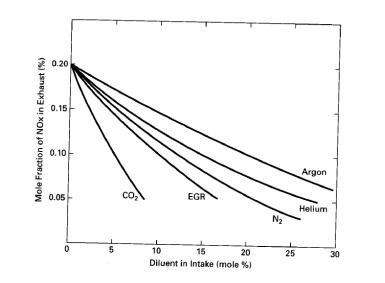Chapter: Mechanical : Advanced IC Engines : Engine Exhaust Emission Control
Exhaust Gas Recycle-EGR
EXHAUST GAS RECYCLE-EGR
The most
effective way of reducing NOx emissions is to hold combustion chamber temperatures
down. Although practical, this is a very unfortunate method in that it also
reduces the thermal efficiency of the engine. We have been taught since infancy
in our first thermodynamics course that for maximum engine thermal efficiency,
Qin should be at the highest temperature possible.
Probably
the simplest practical method of reducing maximum flame temperature is to
dilute the air-fuel mixture with a non-reacting parasite gas. This gas absorbs
energy during combustion without contributing any energy input. The net result
is a lower flame temperature. Any non-reacting gas would work as a diluent, as
shown in Fig. Those gases with larger specific heats would absorb the most
energy per unit mass and would therefore require the least amount; thus less
C02 would be required than argon for the same maximum temperature. However,
neither C02 nor argon is readily available for use in an engine. Air is
available as a diluent but is not totally non-reacting. Adding air changes the
AF and combustion characteristics. The one
Non-reacting
gas that is available to use in an engine is exhaust gas, and this is used in
all modern automobile and other medium-size and large engines.

Exhaust
gas recycle (EGR) is done by ducting some of the exhaust flow back into the
intake system, usually immediately after the throttle. The amount of flow can
be as high as 30% of the total intake. EGR gas combines with the exhaust
residualleft in the cylinder from the previous cycle to effectively reduce the maximum
combustion temperature.
Not only
does EGR reduce the maximum temperature in the combustion chamber, but it also
lowers the overall combustion efficiency. Above Fig shows that as EGR are
increased, the percent of inefficient slow-burn
cycles increases. Further increase in EGR results in some cycle partial burns and, in the extreme, total
misfires. Thus, by using EGR to reduce NOx emissions, a costly price of
increased HC emissions and lower thermal efficiency must be paid.
The
amount of EGR is controlled by the EMS. By sensing inlet and exhaust conditions
the flow is controlled, ranging from 0 up to 15-30%. Lowest NOx emissions with
relatively good fuel economy occur at about stoichiometric combustion, with as
much EGR as possible without adversely affecting combustion. No EGR is used
during WOT, when maximum power is desired. No EGR is used at idle and very
little at low speeds. Under these conditions, there is already maximum exhaust
residual and greater combustion inefficiency. Engines with fast-burn combustion
chambers can tolerate a greater amount of EGR.
A problem
unique to CI engines when using EGR is the solid carbon soot in the exhaust.
The soot acts as an abrasive and breaks down the lubricant. Greater wear on the
piston rings and valve train results.
NON EXHAUST EMISSIONS:
Engines
and fuel supply systems also have sources of emissions other than exhaust flow.
Historically, these were considered minor and were just released to the
surrounding air.
A major
source of HC emissions was the crankcase breather tube that was vented to the
air in older automobiles. Blow by flow past the pistons ended up in the
crankcase, and due to the higher pressure it created, it was then pushed out
the breather vent tube. Blow by gas is very high in HCs, especially in 81
engines. Also, in older engines with greater clearance between the piston and
cylinder wall, blow by flow was much higher. As much as 1% of the fuel was
vented to the atmosphere through the crankcase breather in some automobiles.
This accounted for up to 20% of total emissions. A simple solution to this
problem, which is used on all modern engines, is to vent the crankcase breather
back into the intake system. This not only reduces emissions but also increases
fuel economy.
To keep
the pressure at one atmosphere in the fuel tank and in the fuel reservoir of a
carburetor, these systems are vented to the surroundings. Historically, these
vents were an additional source of HC emissions when fuel evaporated from these
fuel reservoirs. To eliminate these emissions, fuel vents now include some form
of filter or absorption system which stops the HC vapour from escaping. One
such system absorbs the HCs onto the surface of a carbon filter element. Then,
when the engine is operating, the element is back flushed and the HC is
desorbed off the surface. The recovered HC is ducted into the engine intake
with no resulting emissions.
Many modern gasoline pumps and other fuel-dispensing systems are equipped with vapour-collecting nozzles that reduce HC vapour lost to the atmosphere during refuelling.
Related Topics